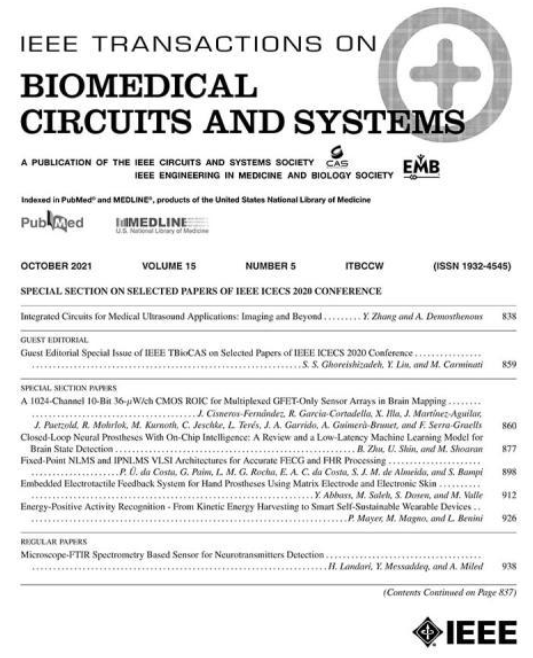生物信号动态自适应压缩感知中的超低功耗动态旋钮
IF 4.9
2区 医学
Q2 ENGINEERING, BIOMEDICAL
IEEE Transactions on Biomedical Circuits and Systems
Pub Date : 2016-01-19
DOI:10.1109/TBCAS.2015.2497304
引用次数: 18
摘要
压缩感知(CS)是一种新兴的数据采集采样模式。其集成的模拟-信息结构可以用低复杂度的硬件同时进行数据感知和压缩。到目前为止,大多数现有的CS实现都有固定的体系结构设置,缺乏灵活性和适应性,无法实现有效的动态数据感知。在本文中,我们提出了一种动态旋钮(DK)设计,通过识别生物信号来有效地重新配置CS架构。具体来说,动态旋钮设计是一个基于模板的结构,由监督学习模块和查表模块组成。我们用封闭的解析形式对DK性能进行建模,并通过动态规划公式对设计进行优化。我们在130纳米工艺上提出了设计,指纹为0.058 mm 2,能耗为187.88 nJ/event。此外,我们使用公开可用的数据集对设计性能进行基准测试。考虑到无线传感中的能量约束,自适应CS架构与传统CS相比,信号重构质量持续提高70%以上。实验结果表明,超低功耗动态旋钮在生物信号动态压缩感知中具有有效的自适应能力,提高了信号质量。本文章由计算机程序翻译,如有差异,请以英文原文为准。
Ultra-Low Power Dynamic Knob in Adaptive Compressed Sensing Towards Biosignal Dynamics
Compressed sensing (CS) is an emerging sampling paradigm in data acquisition. Its integrated analog-to-information structure can perform simultaneous data sensing and compression with low-complexity hardware. To date, most of the existing CS implementations have a fixed architectural setup, which lacks flexibility and adaptivity for efficient dynamic data sensing. In this paper, we propose a dynamic knob (DK) design to effectively reconfigure the CS architecture by recognizing the biosignals. Specifically, the dynamic knob design is a template-based structure that comprises a supervised learning module and a look-up table module. We model the DK performance in a closed analytic form and optimize the design via a dynamic programming formulation. We present the design on a 130 nm process, with a 0.058 mm 2 fingerprint and a 187.88 nJ/event energy-consumption. Furthermore, we benchmark the design performance using a publicly available dataset. Given the energy constraint in wireless sensing, the adaptive CS architecture can consistently improve the signal reconstruction quality by more than 70%, compared with the traditional CS. The experimental results indicate that the ultra-low power dynamic knob can provide an effective adaptivity and improve the signal quality in compressed sensing towards biosignal dynamics.
求助全文
通过发布文献求助,成功后即可免费获取论文全文。
去求助
来源期刊

IEEE Transactions on Biomedical Circuits and Systems
工程技术-工程:电子与电气
CiteScore
10.00
自引率
13.70%
发文量
174
审稿时长
3 months
期刊介绍:
The IEEE Transactions on Biomedical Circuits and Systems addresses areas at the crossroads of Circuits and Systems and Life Sciences. The main emphasis is on microelectronic issues in a wide range of applications found in life sciences, physical sciences and engineering. The primary goal of the journal is to bridge the unique scientific and technical activities of the Circuits and Systems Society to a wide variety of related areas such as: • Bioelectronics • Implantable and wearable electronics like cochlear and retinal prosthesis, motor control, etc. • Biotechnology sensor circuits, integrated systems, and networks • Micropower imaging technology • BioMEMS • Lab-on-chip Bio-nanotechnology • Organic Semiconductors • Biomedical Engineering • Genomics and Proteomics • Neuromorphic Engineering • Smart sensors • Low power micro- and nanoelectronics • Mixed-mode system-on-chip • Wireless technology • Gene circuits and molecular circuits • System biology • Brain science and engineering: such as neuro-informatics, neural prosthesis, cognitive engineering, brain computer interface • Healthcare: information technology for biomedical, epidemiology, and other related life science applications. General, theoretical, and application-oriented papers in the abovementioned technical areas with a Circuits and Systems perspective are encouraged to publish in TBioCAS. Of special interest are biomedical-oriented papers with a Circuits and Systems angle.
 求助内容:
求助内容: 应助结果提醒方式:
应助结果提醒方式:


